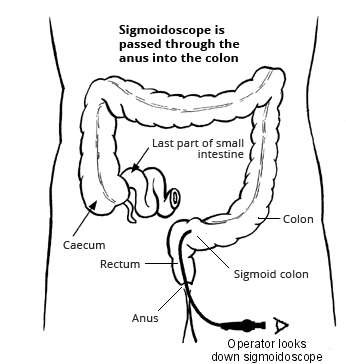What is a flexible sigmoidoscopy?
A sigmoidoscopy is a routine test to examine the lining of your sigmoid colon. This is the lower part of your colon, also called your bowel or large intestine. The examination uses an endoscope, which is a flexible tube about the thickness of your little finger, with a camera and light at one end. It is passed through your anus (back passage) and carefully moved around your large bowel. Sometimes biopsies (small tissue samples) of your bowel may be taken for analysis. The procedure is not usually painful but it may be a little uncomfortable.
There are two types of sigmoidoscope that can be used. The most commonly used is the flexible sigmoidoscope. This instrument allows your doctor to see around bends in the colon. A flexible sigmoidoscope gives doctors a better view of the lower colon and usually makes the examination more comfortable.

What is a sigmoidoscopy used for?
Sigmoidoscopy can be used to investigate the cause of bleeding or pain from the back passage. Your consultant may also suggest this test if you have various other bowel-related symptoms. The test can also look for evidence of inflammation or cancer of the rectum and lower colon. Sigmoidoscopy can also be used to remove small fleshy lumps (polyps) that can be found in the colon and take samples of tissue (biopsy) for analysis. This is done by passing a thin ‘grabbing’ instrument down a side channel of the sigmoidoscope.
The test itself
This test takes just a few minutes. Usually you do not need an anaesthetic or sedation.
First the doctor will gently insert a gloved and lubricated finger (or fingers) into the rectum to check for blockage and to widen the back passage (anus). Then the sigmoidoscope will be inserted and gently pushed further into the rectum and colon. Air is gently pumped through the sigmoidoscope to help viewing. This can cause you to feel bloated and uncomfortable and give you an urge to move your bowels (defecate). As the sigmoidoscope is slowly removed, the lining of the bowel is carefully examined.
A small sample (biopsy) of bowel lining may be taken during the procedure. The sample is sent to the laboratory to be looked at under the microscope. It may also be tested for various conditions that can affect the bowel.
Are there any side-effects or complications from a sigmoidoscopy?
Most sigmoidoscopies are done without any problem. Some people have some crampy pains and excess wind after the procedure.
You may also have leakage of liquid accompanied by gas for up to 24 hours after taking the last dose of laxatives. You should arrange your work/social activities following a sigmoidoscopy with this in mind.
Occasionally, the sigmoidoscope causes some damage to the rectum or colon. This may cause bleeding, infection and (rarely) a hole (perforation) in the colon. If any of the following occur within 48 hours after a sigmoidoscopy, consult a doctor immediately:
- Severe tummy (abdominal) pain.
- Bloody bowel movements or rectal bleeding.
- Raised temperature (fever).
Screening for bowel (colorectal) cancer with flexible sigmoidoscopy
A routine flexible sigmoidoscopy test is sometimes offered to older adults to screen for bowel cancer. This is because most bowel small fleshy lumps (polyps) and colorectal cancers develop in the rectum, sigmoid colon or lower descending colon. Bowel (colonic) polyps are small non-cancerous (benign) growths on the inside lining of the colon or rectum. They are common in older people. They usually cause no symptoms or problems. However, if a polyp is found, it is usually removed. This is because there is a small risk of a colonic polyp developing into a bowel cancer after several years.
